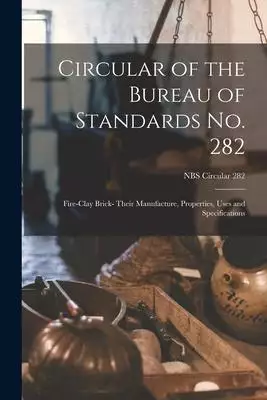Clay brick的問題,我們搜遍了碩博士論文和台灣出版的書籍,推薦Anonymous寫的 Circular of the Bureau of Standards No. 282: Fire-clay Brick- Their Manufacture, Properties, Uses and Specifications; NBS Circul 和Moffett, Helen (EDT)/ Africa Day Story Short (COM)的 Hotel Africa: New Short Fiction from Africa都 可以從中找到所需的評價。
這兩本書分別來自 和所出版 。
國立臺灣科技大學 營建工程系 廖敏志所指導 Tarekegn Kumala Sherre的 再生礦物填充料類型與含量對密級配熱拌瀝青混凝土力學特性之影響 (2021),提出Clay brick關鍵因素是什麼,來自於。
而第二篇論文朝陽科技大學 環境工程與管理系 章日行所指導 曾子傑的 改質生物炭吸附廢水中氨氮及硝酸根離子之研究 (2021),提出因為有 吸附、生物炭、雙氫氧化物(LDHs)、硝酸鹽的重點而找出了 Clay brick的解答。
Circular of the Bureau of Standards No. 282: Fire-clay Brick- Their Manufacture, Properties, Uses and Specifications; NBS Circul

為了解決Clay brick 的問題,作者Anonymous 這樣論述:
Clay brick進入發燒排行的影片
We built ancient brick kilns with clay and peat. I made brick kilns using the ancient method my ancestors did. It is a manual method that we have learned. It helped our ancestors build the best works of the time. Initially we used clay to build the furnace, we went to a stream with coal mines to get peat. peat is formed after coal erosion. we have bricked in the previous video and took that brick to wiggle in the oven. It takes a long time for the tiles to ripen, which takes about 24 hours. The result that after many efforts we have been very good bricks. We will make lots of bricks to carry out these projects later. Maybe we will build a miniature ancient city. Thanks for watching. Subscribe to the channel to follow the new videos.
再生礦物填充料類型與含量對密級配熱拌瀝青混凝土力學特性之影響
為了解決Clay brick 的問題,作者Tarekegn Kumala Sherre 這樣論述:
Investigation of recycled waste materials as a replacement of conventional filler is one alternative problem solving mechanism in hot mix asphalt (HMA). This study was designed to analyze the characteristics of two recycled fillers called hollow concrete block (HCB) powder and brick powder (BP), to
assess impacts of filler type and content on the mechanical and cracking properties of hot mix asphalt (HMA) at 3%, 5% and 7% as a full replacements for limestone (LS) filler. The recycled materials and limestone fillers obtained from construction and demolition wastes (CDW) site, and naturally min
ed for commercial uses, respectively. Filler characteristics were examined using different cutting-edge technologies, such as laser diffraction particle size analysis (LDS), Fourier transform infrared (FTIR), Brunauer, Emmette, and Teller method (BET), X-ray diffractometer (XRD), scanning electron m
icroscope (SEM) and energy dispersive x-ray spectroscopy (EDS). Rotational viscosity and dynamic rheological properties of asphalt mastic with recycled filler over a wide range of frequencies and temperatures have shown better values than the conventional filler. The respective effects of the recycl
ed fillers and the mechanical properties of the HMA mixtures were assessed by investigating superpave volumetric analysis, indirect tensile strength (ITS), moisture damage by tensile strength ratio (TSR), permanent deformation and indirect tensile cracking indices (IDTindex) tests. The analysis of t
he volumetric properties revealed that the 5% of each fillers content was considered as an optimum filler content in the mixtures among the three fillers percentages (3%, 5% and 7%). Thus, the mechanical properties had investigated at the optimum 5%, except for IDT crack tests that used three differ
ent % of fillers. The results demonstrated that mixture with the HCB powder recorded a 6% higher TSR value than the LS mixture and 7.2% higher TSR value than the BP mixture. Mixtures with the HCB powder significantly improved the moisture, rutting, and cracking resistance of the HMA, which are fact
ors critical to extend the life of asphalt concrete. In contrast, using BP results in mixed values and negative effects particularly in terms of moisture resistance and rutting. The filler concentrations had also significant effect on the cracking performance of the asphalt. Peak loads and fracture
energy were increased as filler percentages were increased from 3%, 5% to 7% while the cracking indices such as cracking tolerance index (CT-index), flexibility index (FI), fractural energy index (FEI), toughness index (TI), crack resistance index (CRI), and fracture strain tolerance ( FST) were gov
erned at the 5% filler concentration. Strong linear correlations were observed for the R2 values of 0.89, 0.85, 0.84 and 0.68 for the CT index, FI, FEI, and TI, respectively, while a moderate correlation with 0.52 R2 for CRI and a weak correlation with 0.44 R2 for FST were observed between both spec
imen diameters. Therefore, both of the specimen diameters examined in this study (100mm and 150mm) may use interchangeably to characterize the crack performance of HMA using the IDT test due to the test results found and discriminated low variability of cracking indices.
Hotel Africa: New Short Fiction from Africa

為了解決Clay brick 的問題,作者Moffett, Helen (EDT)/ Africa Day Story Short (COM) 這樣論述:
Check-in... To five-star neon-lit luxury. To budget motels with the option to pay by the hour. To intimate anonymous rooms wiped clean every twenty-four hours or clammy beds where remnants of yesterday's guests still lurk. Check-in... Lovers, aid workers, businessmen local and foreign, wedding guest
s, gap-year travellers, volunteer tourists, honeymooners, UN soldiers, politicians, adventure seekers, evangelists, holidaymakers, warmongers, peacekeepers. Check-in... To hotels made of brick and cement and blood and sweat. Hotels made of corrugated iron and clay and hope and faith. Hotels celebrat
ed, hotels forgotten. Hotels that have served as shelter for the night or refuge when the shots rang out. Check-in to Hotel Africa. The latest Short Story Day Africa prize and anthology theme is Hotel Africa. Innovative short fiction set in the rooms, the passages, the bars and the lobbies of hotels
across the continent, as well as metafiction exploring Africa as a hotel herself. If these walls could talk, what story would they tell?
改質生物炭吸附廢水中氨氮及硝酸根離子之研究
為了解決Clay brick 的問題,作者曾子傑 這樣論述:
硝酸鹽是工業製程不可或缺的原料,由於其在水中的高穩定性和溶解性,導致工業廢水中常含有高濃度的硝酸根離子,因而形成高導電度廢水,近年來水中去除硝酸鹽成為廢水處理技術挑戰之一。本研究利用農業廢棄物製備生物炭,並整合共沉澱法,以「氯化鎂(MgCl2)、氯化鈣(CaCl2)」製備成富含有Mg/Ca之層狀雙氫氧化物(Mg/Ca- double hydroxides)以成為新的複合材料吸附劑,探討其對水中硝酸根離子的吸附能力。研究發現當添加愈高鎂鈣比時LDHs中的鎂含量較高,但當在4:1和3:1的比例時卻有所不同,在3:1所披覆上的鎂較多。生物炭的孔洞接成蜂巢狀,孔洞直徑約為10微米,推測其可能為植物管
胞碳化後的組織形狀。此外,隨著鎂鈣比逐漸增加,生物碳的孔洞似乎愈加破碎。生物炭的比表面積隨著鎂鈣比增加而增加,其中3:1及4:1鎂鈣比的比表面積最高,約可達到100 cm2/g。3:1的Mg/Ca-LDHs在吸附時間約3分鐘時能有效吸附水中硝酸根離子,同時LDHs在吸附過程中維持穩定狀態。此說明3:1鎂鈣比生物炭LDHs不僅具有最佳的比表面積及鎂鈣LDHs吸附層,同時具有最佳的硝酸根離子吸附能力。